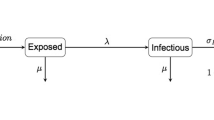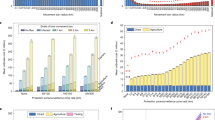Abstract
The 2001 epidemic of foot-and-mouth disease in the United Kingdom triggered a livestock culling campaign that involved the slaughter of more than 6.5 million animals. Three years later, management of the epidemic remains controversial. Some believe that untried control methods based on unvalidated models replaced well-established policy, motivating an unnecessary slaughter. Others hold that rigorous quantitative approaches provided the basis for new incisive policies that significantly curtailed the epidemic. Now, new and more flexible control policies have been adopted throughout Europe. For these policies to receive the full confidence of scientists, veterinarians and the general public, it is necessary that we improve both our understanding of where, how and why control measures initially failed in 2001 and how new policies should be implemented.
This is a preview of subscription content, access via your institution
Access options
Subscribe to this journal
Receive 12 print issues and online access
$209.00 per year
only $17.42 per issue
Buy this article
- Purchase on Springer Link
- Instant access to full article PDF
Prices may be subject to local taxes which are calculated during checkout

Similar content being viewed by others
References
Correa Melo, E., Saraiva, V. & Astudillo, V. Review of the status of foot and mouth disease in countries of South America and approaches to control and eradication. Rev. Sci. Tech. 21, 429–436 (2002).
Thomson, G. R. et al. Shifting paradigms in international animal health standards: the need for comprehensive standards to enable commodity based trade. [online] <http://www.eldis.org/fulltext/shiftingparadigms.pdf> (2004).
Woods, A. To vaccinate or vacillate? The British response to foot and mouth disease, 1920–2001. Hist. Res. (in the press).
Northumberland. Report of the Committee of Inquiry on Foot-and-Mouth Disease. (Her Majesty's Stationery Office, London, 1969).
The Royal Society. Inquiry into Infectious Diseases in Livestock. (The Stationery Office, London, 2002) [online], <http://www.royalsoc.ac.uk/inquiry/index.html> (2002).
Anderson, I. Foot and Mouth Disease 2001: Lessons to be Learned Inquiry [online], <http://www.defra.gov.uk/corporate/inquiries/lessons/index.htm> (2001).
DEFRA. Foot and Mouth Disease — contingency plan. [online] <http://www.defra.gov.uk/footandmouth/contingency/index.htm> (2004).
Tinline, R. Lee wave hypothesis for the initial pattern of spread during the 1967–68 foot and mouth epizootic. Nature 227, 860–862 (1970).
Haydon, D. T., Woolhouse, M. E. J. & Kitching, R. P. An analysis of foot-and-mouth-disease epidemics in the UK. IMA J. Math. Appl. Med. Biol. 14, 1–9 (1997).
Gibbens, J. C. et al. Descriptive epidemiology of the 2001 foot-and-mouth disease epidemic in Great Britain: the first five months. Vet. Rec. 149, 729–743 (2001).
Haydon, D. T. et al. The construction and analysis of epidemic trees with reference to the 2001 UK foot-and-mouth outbreak. Proc. R Soc. Lond. B Biol. Sci. 270, 121–127 (2003).
Mansley, L. M., Dunlop, P. J., Whiteside, S. M. & Smith, R. G. Early dissemination of foot-and-mouth disease virus through sheep marketing in February 2001. Vet. Rec. 153, 43–50 (2003).
Keeling, M. J. et al. Dynamics of the 2001 UK foot and mouth epidemic: stochastic dispersal in a heterogeneous landscape. Science 294, 813–817 (2001).
Gibbens, J. C. & Wilesmith, J. W. Temporal and geographical distribution of cases of foot-and-mouth disease during the early weeks of the 2001 epidemic in Great Britain. Vet. Rec. 151, 407–412 (2002).
Donaldson, A. I., Alexandersen, S., Sorensen, J. H. & Mikkelsen, T. Relative risks of the uncontrollable (airborne) spread of FMD by different species. Vet. Rec. 148, 602–604 (2001).
Fraser, C., Riley, S., Anderson, R. M. & Ferguson, N. M. Factors that make an infectious disease outbreak controllable. Proc. Natl Acad. Sci. USA 101, 6146–6151 (2004).
Alexandersen, S. & Donaldson, A. I. Further studies to quantify the dose of natural aerosols of foot-and-mouth disease virus for pigs. Epidemiol. Infect. 128, 313–323 (2002).
Matthews, L. et al. Neighbourhood control policies and the spread of infectious diseases. Proc. R. Soc. Lond. B Biol. Sci. 270, 1659–1666 (2003).
Morris, R. S., Wilesmith, J. W., Stern, M. W., Sanson, R. L. & Stevenson, M. A. Predictive spatial modelling of alternative control strategies for the foot-and-mouth disease epidemic in Great Britain, 2001. Vet. Rec. 149, 137–144 (2001).
Ferguson, N. M., Donnelly, C. A. & Anderson, R. M. Transmission intensity and impact of control policies on the foot and mouth epidemic in Great Britain. Nature 413, 542–548 (2001).
Ferguson, N. M., Donnelly, C. A. & Anderson, R. M. The foot-and-mouth epidemic in Great Britain: pattern of spread and impact of interventions. Science 292, 1155–1160 (2001).
Phillips, N., Bridgeman, J. & Ferguson–Smith, M. Report of the Inquiry into BSE and Variant CJD in the United Kingdom. (Her Majesty's Stationery Office, London, 1999).
Kao, R. R. The role of mathematical modelling in the control of the 2001 FMD epidemic in the UK. Trends Microbiol. 10, 279–286 (2002).
Woolhouse, M. E. Foot-and-mouth disease in the UK: what should we do next time? J. Appl. Microbiol. 94, S126–S130 (2003).
Alexandersen, S., Kitching, R. P., Mansley, L. M. & Donaldson, A. I. Clinical and laboratory investigations of five outbreaks of foot-and-mouth disease during the 2001 epidemic in the United Kingdom. Vet. Rec. 152, 489–496 (2003).
Kao, R. R. The impact of local heterogeneity on alternative control strategies for foot-and-mouth disease. Proc. R. Soc. Lond. B Biol. Sci. 270, 2557–2564 (2003).
Gloster, J. et al. Airborne transmission of foot-and-mouth disease virus from Burnside Farm, Heddon-on-the-Wall, Northumberland, during the 2001 epidemic in the United Kingdom. Vet. Rec. 152, 525–533 (2003).
Mikkelsen, T. et al. Investigation of airborne foot-and-mouth disease virus transmission during low-wind conditions in the early phase of the UK 2001 epidemic. Atmos. Chem. Phys. Disc. 3, 677–703 (2003).
Wingfield, A. S., Middlemiss, C. H. & Eppink, L. FMD control strategies. Vet. Rec. 152, 479–480 (2003).
Taylor, N. M., Honhold, N., Paterson, A. D. & Mansley, L. M. Risk of foot-and-mouth disease associated with proximity in space and time to infected premises and the implications for control policy during the 2001 epidemic in Cumbria. Vet. Rec. 154, 617–626 (2004).
National Audit Office. Report by the Comptroller and Auditor General: The 2001 Outbreak of Foot and Mouth Disease. (The Stationery Office, London, 2002) [online], <http://www.nao.org.uk/publications/nao_reports/01-02/0102939part1.pdf>, <http://www.nao.org.uk/publications/nao_reports/01-02/0102939part2.pdf> (2002).
Thompson, D. et al. Economic costs of the foot and mouth disease outbreak in the United Kingdom in 2001. Rev. Sci. Tech. 21, 675–687 (2002).
Royal Society (Edinburgh). Inquiry Into Foot and Mouth Disease in Scotland. (Royal Society of Edinburgh, Edinburgh, 2002).
Sutmoller, P. & Olascoaga, R. C. in Evidence for the Temporary Committee on Foot-and–Mouth Disease of European Parliament. Meeting 2nd Sept. (European Parliament 2002).
Bouma, A. et al. The foot-and-mouth disease epidemic in The Netherlands in 2001. Prev. Vet. Med. 57, 155–166 (2003).
Barnett, P. V. & Carabin, H. A review of emergency foot-and-mouth disease (FMD) vaccines. Vaccine 20, 1505–1514 (2002).
Donaldson, A. I. & Kitching, R. P. Transmission of foot-and-mouth disease by vaccinated cattle following natural challenge. Res. Vet. Sci. 46, 9–14 (1989).
Barnett, P. V. et al. Evidence that high potency foot-and-mouth disease vaccine inhibits local virus replication and prevents the 'carrier' state in sheep. Vaccine 22, 1221–1232 (2004).
Mackay, D. K., Forsyth, M. A., Davies, P. R. & Salt, J. S. Antibody to the nonstructural proteins of foot-and-mouth disease virus in vaccinated animals exposed to infection. Vet. Q. 20, S9–11 (1998).
The Council of the European Union. Council Directive 2003/85/EC. Official J. European Union L 306, 1–41 (2003).
Eddy, R. Vets asked valuable questions about foot-and-mouth measures. Nature 412, 477 (2001).
Haydon, D. T., Samuel, A. R. & Knowles, N. J. The generation and persistence of genetic variation in foot-and-mouth disease virus. Prev. Vet. Med. 51, 111–124 (2001).
Donaldson, A. I., Gloster, J., Harvey, L. D. & Deans, D. H. Use of prediction models to forecast and analyse airborne spread during the foot-and-mouth disease outbreaks in Brittany, Jersey and the Isle of Wight in 1981. Vet. Rec. 110, 53–57 (1982).
Donaldson, A. Foot-and-mouth disease: the principal features. Ir. Vet. J. 41, 325–327 (1987).
Alexandersen, S., Zhang, Z., Donaldson, A. I. & Garland, A. J. The pathogenesis and diagnosis of foot-and-mouth disease. J. Comp. Pathol. 129, 1–36 (2003).
Woolhouse, M. E. J., Haydon, D. T., Pearson, A. & Kitching, R. P. Failure of vaccination to prevent outbreaks of foot-and-mouth disease. Epidemiol. Infect. 116, 363–371 (1996).
Hughes, G. J. et al. Serial passage of foot-and-mouth disease virus in sheep reveals declining levels of viraemia over time. J. Gen. Virol. 83, 1907–1914 (2002).
Bouma, A., Dekker, A. & de Jong, M. C. No foot-and-mouth disease virus transmission between individually housed calves. Vet. Microbiol. 98, 29–36 (2004).
Woolhouse, M. E. J. et al. Foot-and-mouth disease under control in the UK. Nature 411, 258–259 (2001).
Kao, R. R. Landscape fragmentation and foot-and-mouth disease transmission. Vet. Rec. 148, 746–747 (2001).
Acknowledgements
We thank the anonymous referees for their helpful comments and many colleagues for advice that has greatly improved the various drafts of this manuscript. R.R.K. is funded by the Wellcome Trust.
Author information
Authors and Affiliations
Corresponding author
Ethics declarations
Competing interests
The authors declare no competing financial interests.
Related links
Related links
FURTHER INFORMATION
DEFRA Summary report of the foot-and-mouth disease modelling workshop
Glossary
- FIREBREAK CULLING
-
The culling of animals for the purpose of preventing spread of infection beyond an area, even though the animals are not believed to have been exposed to infection.
- VACCINATION TO KILL
-
Or suppressive vaccination. A vaccination policy adopted within the protection zone that anticipates that vaccinated individuals will be destroyed as soon as circumstances allow.
- VACCINATION TO LIVE
-
Or protective vaccination. A vaccination policy that anticipates that vaccinated individuals will not be prematurely slaughtered, and will enter the food chain as normal.
Rights and permissions
About this article
Cite this article
Haydon, D., Kao, R. & Kitching, R. The UK foot-and-mouth disease outbreak — the aftermath. Nat Rev Microbiol 2, 675–681 (2004). https://doi.org/10.1038/nrmicro960
Issue Date:
DOI: https://doi.org/10.1038/nrmicro960
This article is cited by
-
A systemic approach to assess the potential and risks of wildlife culling for infectious disease control
Communications Biology (2020)
-
Forecasting the 2001 Foot-and-Mouth Disease Epidemic in the UK
EcoHealth (2018)
-
Bridging Taxonomic and Disciplinary Divides in Infectious Disease
EcoHealth (2011)
-
The OptAIDS project: towards global halting of HIV/AIDS
BMC Public Health (2009)



